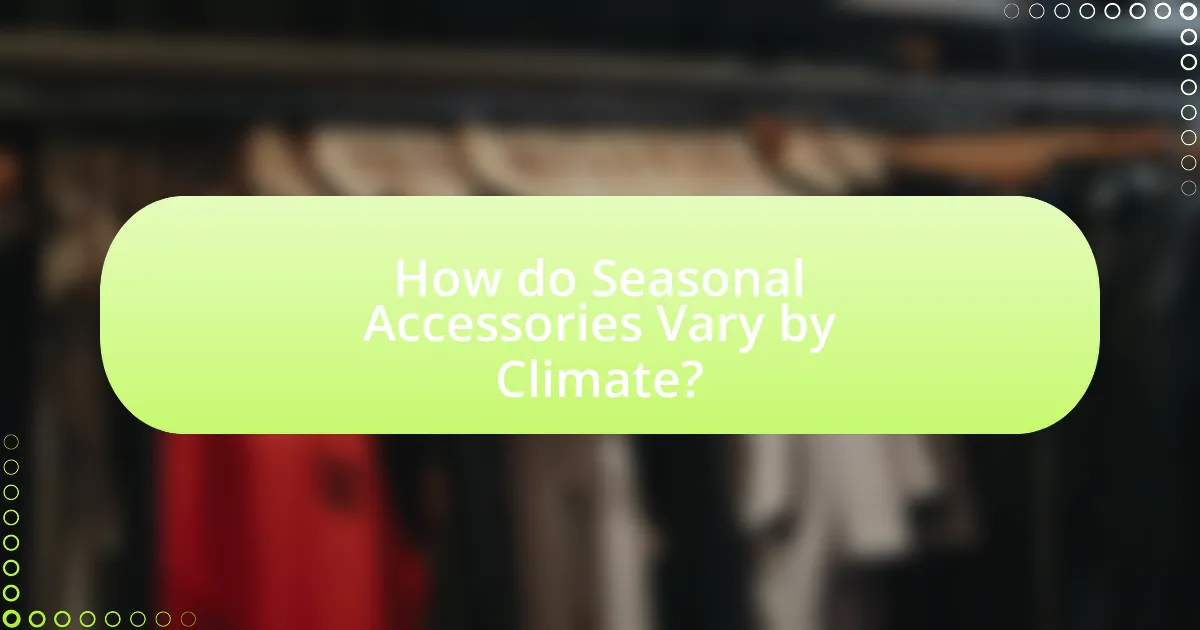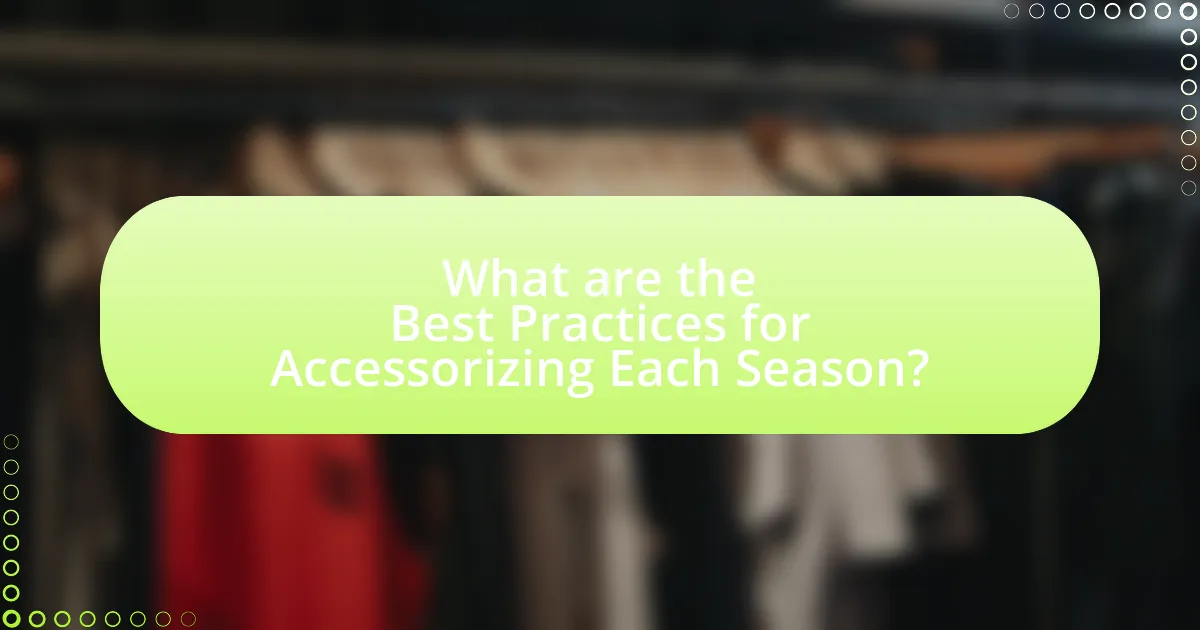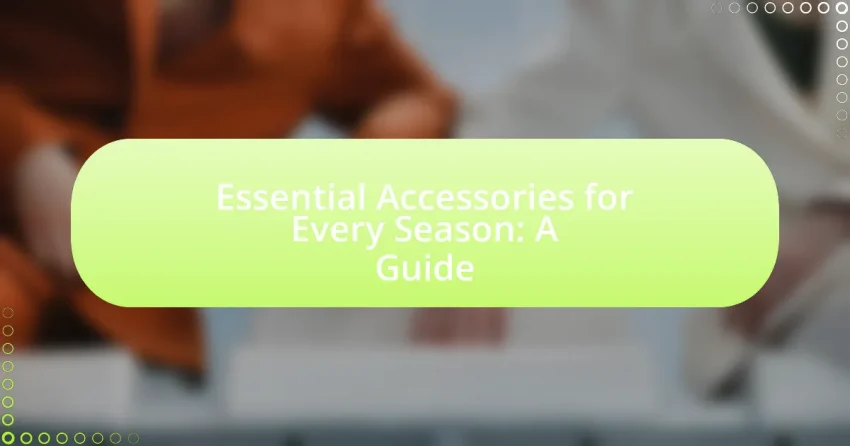Essential Accessories for Every Season is a comprehensive guide that outlines the crucial items needed to adapt to varying weather conditions throughout the year. The article details essential accessories for each season, including scarves, hats, gloves, sunglasses, and umbrellas, highlighting their functional benefits and style contributions. It emphasizes the importance of accessories in enhancing personal expression and versatility in wardrobes, while also addressing how climate influences accessory choices. Additionally, the article provides practical tips for selecting and coordinating accessories, avoiding common mistakes, and understanding seasonal trends to maintain comfort and style year-round.

What are Essential Accessories for Every Season?
Essential accessories for every season include scarves, hats, gloves, sunglasses, and umbrellas. Scarves provide warmth in winter and can be stylish in spring and fall. Hats protect from sun exposure in summer and keep warmth in winter. Gloves are essential for cold weather, while sunglasses shield eyes from UV rays in summer. Umbrellas are necessary for rainy days across all seasons, ensuring comfort and protection from the elements.
Why are accessories important for seasonal wardrobes?
Accessories are important for seasonal wardrobes because they enhance versatility and allow for personal expression while adapting to changing weather conditions. For instance, a simple outfit can be transformed with seasonal accessories like scarves, hats, or jewelry, making it suitable for various occasions and climates. Additionally, accessories can provide functional benefits, such as warmth in winter or sun protection in summer, thereby improving comfort and practicality. Studies show that incorporating accessories can increase the perceived value of an outfit, making it more visually appealing and fashionable.
How do accessories enhance functionality in different seasons?
Accessories enhance functionality in different seasons by providing practical benefits tailored to specific weather conditions. For instance, in winter, accessories like scarves, gloves, and hats offer warmth and protection against cold temperatures, while in summer, items such as sunglasses and hats shield against UV rays and provide comfort from heat. Additionally, multifunctional accessories like waterproof bags or insulated water bottles adapt to seasonal needs, ensuring convenience and utility throughout the year. This adaptability of accessories is crucial for maintaining comfort and style, regardless of the season.
What role do accessories play in personal style throughout the year?
Accessories play a crucial role in personal style throughout the year by enhancing outfits and allowing for individual expression. They serve as versatile elements that can transform a basic look into a statement ensemble, adapting to seasonal trends and personal preferences. For instance, in winter, scarves and hats not only provide warmth but also add texture and color, while in summer, sunglasses and lightweight jewelry can elevate a casual outfit. The ability of accessories to shift the tone of an outfit is supported by fashion studies, which indicate that accessories can account for up to 30% of an individual’s overall style impact. This adaptability makes accessories essential for maintaining a fresh and personalized appearance across different seasons.
What types of accessories are essential for each season?
Essential accessories for each season include scarves and gloves for winter, sunglasses and hats for summer, and lightweight layers for spring and fall. In winter, scarves and gloves provide warmth and protection against cold weather, while in summer, sunglasses shield eyes from UV rays and hats offer sun protection. Spring and fall require lightweight layers to adapt to fluctuating temperatures, ensuring comfort throughout the day. These accessories are crucial for maintaining comfort and style across varying seasonal conditions.
What accessories are must-haves for spring?
Must-have accessories for spring include lightweight scarves, sunglasses, and crossbody bags. Lightweight scarves provide versatility and can be used for warmth during cooler spring evenings, while sunglasses protect against UV rays and enhance visibility on sunny days. Crossbody bags offer convenience and style, allowing for hands-free movement during outdoor activities. These accessories are essential for adapting to the fluctuating spring weather and complementing seasonal outfits.
Which accessories should be included in a summer wardrobe?
A summer wardrobe should include sunglasses, wide-brimmed hats, lightweight scarves, and beach bags. Sunglasses protect the eyes from UV rays, while wide-brimmed hats provide shade and help prevent sunburn. Lightweight scarves can be used for added style or protection against sun exposure, and beach bags are essential for carrying items to the beach or pool. These accessories not only enhance summer outfits but also serve practical purposes in hot weather.
What are the key accessories for fall fashion?
Key accessories for fall fashion include scarves, hats, gloves, and boots. Scarves provide warmth and can be styled in various ways, while hats, such as beanies or fedoras, add both warmth and a fashionable touch. Gloves are essential for keeping hands warm, and stylish boots, whether ankle or knee-high, complement fall outfits and provide comfort during cooler weather. These accessories not only serve practical purposes but also enhance the overall aesthetic of fall wardrobes.
How can winter accessories keep you warm and stylish?
Winter accessories keep you warm and stylish by combining functionality with fashion. Items such as hats, scarves, gloves, and thermal layers are designed to trap heat and protect against cold weather while also enhancing an outfit’s aesthetic appeal. For instance, wool or cashmere scarves not only provide insulation but also add texture and color to winter attire. Studies show that wearing layered clothing, including stylish accessories, can improve thermal comfort by up to 30%, demonstrating their effectiveness in maintaining warmth without sacrificing style.

How do Seasonal Accessories Vary by Climate?
Seasonal accessories vary significantly by climate, as they are designed to meet the specific needs of different weather conditions. In cold climates, accessories such as heavy scarves, gloves, and insulated hats are essential for warmth, while in warmer climates, lightweight items like sun hats, sunglasses, and breathable scarves are preferred to provide protection from heat and sun exposure. For example, regions with harsh winters require thermal materials for accessories to retain body heat, whereas tropical areas prioritize UV protection and moisture-wicking fabrics. This variation is crucial for comfort and functionality, reflecting the direct relationship between climate and accessory design.
What considerations should be made for different climates?
Different climates require specific considerations for appropriate accessories. In cold climates, insulation, waterproof materials, and thermal accessories like gloves and hats are essential to maintain warmth and prevent frostbite. Conversely, in hot climates, breathable fabrics, sun protection accessories such as hats and sunglasses, and moisture-wicking materials are crucial to prevent overheating and sunburn. Additionally, in humid climates, lightweight and quick-drying materials are necessary to manage sweat and discomfort. These considerations are supported by studies indicating that appropriate clothing and accessories can significantly impact comfort and health in varying weather conditions.
How do accessories differ in tropical versus temperate climates?
Accessories in tropical climates typically prioritize lightweight, breathable materials to accommodate high humidity and temperatures, while accessories in temperate climates often focus on versatility and layering due to varying seasonal temperatures. For instance, tropical accessories may include wide-brimmed hats, lightweight scarves, and sunglasses to protect against sun exposure, whereas temperate accessories might consist of heavier scarves, gloves, and beanies to provide warmth during colder months. This distinction is supported by the fact that tropical regions experience consistent warmth year-round, necessitating accessories that enhance comfort and sun protection, while temperate regions experience seasonal changes, requiring accessories that can adapt to both warm and cold conditions.
What are the unique accessory needs for cold climates?
Cold climates require specific accessories to ensure warmth and protection against harsh weather conditions. Essential accessories include insulated gloves, thermal hats, scarves, and waterproof boots. Insulated gloves prevent heat loss from hands, while thermal hats retain body heat, as up to 30% of heat can escape through the head. Scarves provide additional warmth around the neck and can be wrapped to protect the face from wind. Waterproof boots are crucial for keeping feet dry and warm in snow and slush, as wet feet can lead to frostbite. These accessories are designed to combat the unique challenges posed by cold environments, ensuring comfort and safety.
How can you choose the right accessories for your lifestyle?
To choose the right accessories for your lifestyle, assess your daily activities and personal style preferences. For instance, if you lead an active lifestyle, opt for functional accessories like a durable backpack or a smartwatch that tracks fitness. Conversely, if your routine involves professional settings, select elegant items such as a classic watch or a structured handbag that complements your attire. Research indicates that accessories can enhance personal expression and functionality; a study by the Fashion Institute of Technology found that 70% of individuals feel more confident when wearing accessories that align with their lifestyle. Therefore, aligning your accessory choices with your daily needs and aesthetic preferences ensures both practicality and style.
What factors should influence your accessory choices?
Accessory choices should be influenced by personal style, occasion, functionality, and seasonal trends. Personal style reflects individual preferences and helps in selecting accessories that complement one’s wardrobe. The occasion dictates the appropriateness of certain accessories; for example, formal events may require elegant pieces, while casual outings allow for more relaxed options. Functionality is crucial, as accessories should serve a purpose, such as providing warmth in winter or enhancing comfort. Seasonal trends also play a role, as certain colors and styles become popular during specific times of the year, influencing what accessories are in demand.
How do personal activities affect accessory selection?
Personal activities significantly influence accessory selection by dictating the functional and aesthetic requirements of the items chosen. For instance, individuals engaging in outdoor sports may prioritize durable and weather-resistant accessories, such as sports watches or caps, while those attending formal events might select elegant jewelry or sophisticated bags. Research indicates that lifestyle choices directly correlate with fashion preferences, as seen in a study by the Fashion Institute of Technology, which found that 70% of consumers consider their daily activities when selecting accessories. This demonstrates that the nature of personal activities shapes not only the practicality but also the style of accessories chosen.

What are the Best Practices for Accessorizing Each Season?
The best practices for accessorizing each season include selecting items that complement the seasonal colors, textures, and overall aesthetic. In spring, opt for lightweight scarves and floral jewelry to enhance the fresh, vibrant atmosphere. Summer accessories should focus on breathable materials like straw hats and sunglasses to provide sun protection while maintaining style. In autumn, incorporate layered accessories such as chunky knit scarves and statement belts that add warmth and depth to outfits. Winter calls for functional yet stylish accessories like gloves, beanies, and layered jewelry that can add elegance while keeping you warm. These practices ensure that accessories not only enhance the outfit but also align with seasonal trends and practical needs.
How can you effectively mix and match seasonal accessories?
To effectively mix and match seasonal accessories, start by selecting a cohesive color palette that complements your wardrobe. This approach allows for versatility, as accessories in similar hues can be combined seamlessly across different outfits. For example, pairing a warm-toned scarf with a neutral coat creates a balanced look. Additionally, consider the textures and materials of your accessories; mixing fabrics like leather with softer materials can add depth to your ensemble. According to fashion experts, layering accessories such as necklaces or bracelets can also enhance your overall style while maintaining a seasonal theme. This method not only showcases personal style but also ensures that each accessory serves a purpose, whether for warmth or aesthetic appeal.
What tips can help you coordinate colors and styles?
To effectively coordinate colors and styles, start by using a color wheel to identify complementary colors, which are opposite each other on the wheel and create a balanced look. Additionally, consider the 60-30-10 rule, where 60% of your outfit is a dominant color, 30% is a secondary color, and 10% is an accent color, ensuring a harmonious blend. Research indicates that color harmony can enhance visual appeal and emotional response, as seen in studies on color psychology.
How can layering accessories enhance your seasonal outfits?
Layering accessories can enhance seasonal outfits by adding depth, texture, and versatility. For instance, combining scarves, necklaces, and bracelets allows individuals to create unique looks that can be easily adjusted for different occasions or weather conditions. Studies in fashion psychology indicate that accessorizing can boost confidence and self-expression, making outfits more personalized and visually appealing. Additionally, layering can help transition outfits between seasons, such as pairing a lightweight scarf with a summer dress or adding a chunky knit to a fall ensemble, thus maximizing wardrobe utility.
What common mistakes should be avoided when accessorizing?
Common mistakes to avoid when accessorizing include over-accessorizing, mismatching styles, and neglecting balance. Over-accessorizing can overwhelm an outfit, making it appear cluttered; for instance, wearing multiple statement pieces simultaneously can detract from their impact. Mismatching styles, such as pairing casual accessories with formal attire, can create a disjointed look. Additionally, neglecting balance, like wearing heavy accessories on one side without counterbalancing, can lead to an unharmonious appearance. These mistakes can undermine the overall aesthetic of an outfit, emphasizing the importance of thoughtful accessorizing.
How can over-accessorizing impact your overall look?
Over-accessorizing can clutter your overall look, making it appear chaotic and detracting from your outfit. When too many accessories are worn simultaneously, they can compete for attention, leading to a lack of focus on the main elements of your attire. For instance, fashion experts suggest that a balanced approach, typically involving one or two statement pieces, enhances visual appeal and sophistication. Studies in fashion psychology indicate that simplicity often conveys elegance, while excessive adornment can overwhelm the viewer, resulting in a less polished appearance.
What are the pitfalls of neglecting seasonal trends?
Neglecting seasonal trends can lead to significant financial losses and missed opportunities for businesses. When companies fail to adapt their inventory and marketing strategies to align with seasonal demand, they risk overstocking items that are out of season, resulting in increased holding costs and potential markdowns. For instance, a study by the National Retail Federation found that retailers who effectively manage seasonal inventory can increase sales by up to 30% during peak seasons. Additionally, neglecting these trends can diminish customer satisfaction, as consumers expect relevant products that cater to their seasonal needs. This disconnect can lead to decreased brand loyalty and a loss of market share to competitors who are more attuned to seasonal shifts.
What are some practical tips for selecting seasonal accessories?
To select seasonal accessories effectively, prioritize versatility, quality, and current trends. Versatile accessories can complement various outfits, ensuring they are useful across multiple occasions. Quality materials enhance durability, making them a worthwhile investment, especially for seasonal items that may face wear and tear. Staying updated on current trends allows for a stylish selection that aligns with seasonal aesthetics, ensuring that the accessories remain fashionable. For instance, during winter, opting for scarves and gloves in neutral colors can match various outfits, while summer may call for vibrant sunglasses and lightweight hats.
